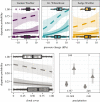Departure, routing and landing decisions of long-distance migratory songbirds in relation to weather
- PMID: 36778957
- PMCID: PMC9905979
- DOI: 10.1098/rsos.221420
Departure, routing and landing decisions of long-distance migratory songbirds in relation to weather
Abstract
Migrating birds flexibly adjust their individual migratory decisions, i.e. departing, routing and landing, based on intrinsic (e.g. energy stores) and extrinsic (e.g. landscape features and weather) factors modulating the endogenous stimuli. So far, these decisions have mostly been studied separately. Notably, we lack information on which factors landing decisions during active flight are based on. Therefore, we simultaneously recorded all three decisions in free-flying long-distance migratory songbirds in a coastal stopover area via regional-scale radio-telemetry and related them to the prevailing weather. Birds departed under favourable weather conditions resulting in specific nights with increased departure probability. Once departed, birds could either fly offshore or take a route along the coast, which was predicted by wind support. Radio-tracking revealed that departed individuals more likely interrupted their migratory endurance flight under overcast or headwind conditions. Studying departure, routing and landing decisions in concert, we highlight the importance of weather as a common driver across all migratory decisions. By radio-tracking individuals between stopovers, we provide evidence that avoidance of adverse weather conditions is an important function of stopover. Understanding how birds adjust migratory decisions and how they affect the timing of migration and survival is key to link migration performance to individual fitness.
Keywords: bird migration; departure decision; landing decision; routing; stopover; weather.
© 2023 The Authors.
Conflict of interest statement
We declare that we have no competing interests.
Figures





Similar articles
-
The urge to breed early: Similar responses to environmental conditions in short- and long-distance migrants during spring migration.Ecol Evol. 2023 Jul 4;13(7):e10223. doi: 10.1002/ece3.10223. eCollection 2023 Jul. Ecol Evol. 2023. PMID: 37408622 Free PMC article.
-
Stopover departure decisions in songbirds: do long-distance migrants depart earlier and more independently of weather conditions than medium-distance migrants?Mov Ecol. 2020 Feb 7;8:6. doi: 10.1186/s40462-020-0193-1. eCollection 2020. Mov Ecol. 2020. PMID: 32047634 Free PMC article.
-
To cross or not to cross - thrushes at the German North Sea coast adapt flight and routing to wind conditions in autumn.Mov Ecol. 2019 Oct 31;7:32. doi: 10.1186/s40462-019-0173-5. eCollection 2019. Mov Ecol. 2019. PMID: 31695918 Free PMC article.
-
Understanding the ecological and evolutionary function of stopover in migrating birds.Biol Rev Camb Philos Soc. 2022 Aug;97(4):1231-1252. doi: 10.1111/brv.12839. Epub 2022 Feb 8. Biol Rev Camb Philos Soc. 2022. PMID: 35137518 Review.
-
How do energy stores and changes in these affect departure decisions by migratory birds? A critical view on stopover ecology studies and some future perspectives.J Comp Physiol A Neuroethol Sens Neural Behav Physiol. 2017 Jul;203(6-7):411-429. doi: 10.1007/s00359-017-1166-8. Epub 2017 Mar 22. J Comp Physiol A Neuroethol Sens Neural Behav Physiol. 2017. PMID: 28332031 Review.
Cited by
-
Migratory strategies across an ecological barrier: is the answer blowing in the wind?Mov Ecol. 2024 Oct 14;12(1):70. doi: 10.1186/s40462-024-00509-2. Mov Ecol. 2024. PMID: 39402693 Free PMC article.
References
-
- Hahn S, Bauer S, Liechti F. 2009. The natural link between Europe and Africa—2.1 billion birds on migration. Oikos 118, 624-626. (10.1111/j.1600-0706.2008.17309.x) - DOI
-
- Briedis M, et al. 2020. Broad-scale patterns of the Afro-Palaearctic landbird migration. Glob. Ecol. Biogeogr. 29, 722-735. (10.1111/geb.13063) - DOI
-
- Bruderer B, Liechti F. 1998. Flight behaviour of nocturnally migrating birds in coastal areas: crossing or coasting. J. Avian Biol. 29, 499-507. (10.2307/3677169) - DOI
-
- Alerstam T, Lindström Å. 1990. Optimal bird migration: the relative importance of time, energy, and safety. In Bird migration (ed. Gwinner E), pp. 331-351. Berlin, Germany: Springer.
Associated data
LinkOut - more resources
Full Text Sources

